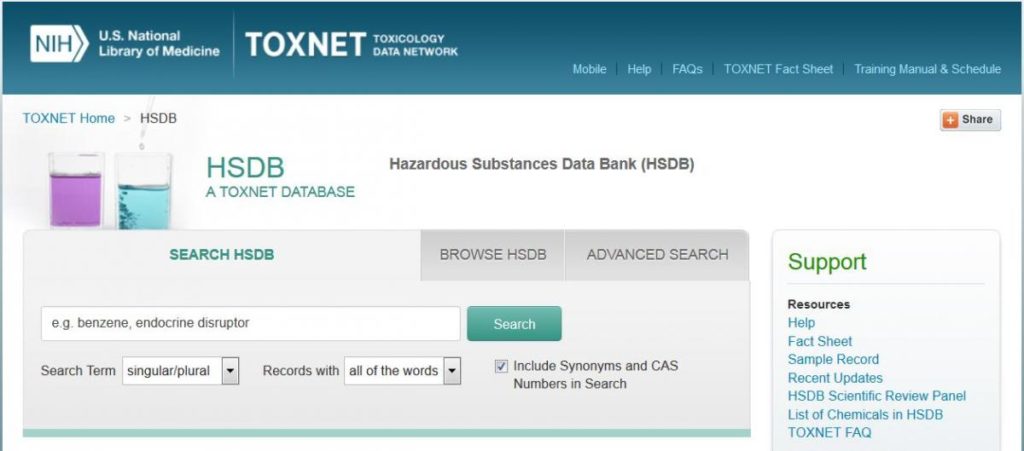Particularly Hazardous Substance
The OSHA laboratory Standard (29 CFR § 1910.1450) broadly defines a Particularly Hazardous Substance (PHS) as a 1.) Carcinogen, 2.) Reproductive Toxin, or 3.) Acute Toxin. A Standard Operating Procedure (SOP) must be written and approved by EH&S before work, utilizing a PHS, may begin.
Ultimately, it is up to the PI or supervisor, in collaboration with EH&S, to determine the degree of hazard a specific chemical poses and the necessary safeguards to implement to ensure safe work. Please use the following reference material to determine whether a chemical is considered a PHS.
Chemical Safety Review Committee (CSRC)
Carcinogens
A carcinogen is a substance capable of causing cancer and is typically a chronically toxic substance. That is, they cause damage after repeated or long-duration exposure and their effects may become evident only after a long latency period. The following is the OSHA-regulated carcinogens list (Subpart Z OSHA Laboratory Standard). This list is NOT all-inclusive; therefore, it is necessary to also reference the chemical SDS plus other hazardous chemical databases if the chemical you are looking for is not listed.
-
- 4-Nitrobiphenyl
- asbestos
- alpha-Naphthylamine
- Methyl chloromethyl ether
- 3,3 -Dichlorobenzidine (and its salts)
- bis-Chloromethyl ether
- beta-Naphthylamine
- Benzidine
- 4-Aminodiphenyl
- Ethyleneimine
- beta-Propiolactone
- 2-Acetylaminofluorene
- 4-Dimethylaminoazobenzene
- N-Nitrosodimethylamine
- Vinyl chloride
- Inorganic arsenic
- Cadmium
- Benzene
- Coke oven emissions
- 1,2-dibromo-3-chloropropane
- Acrylonitrile
- Ethylene oxide
- Formaldehyde
- Methylenedianiline
- 1,3-Butadiene
- Methylene chloride
- Any substance listed under the category, “known to be carcinogens,” in the Annual Report on Carcinogens published by the National Toxicology Program (NTP) (latest edition)
- Any substance listed under Group 1 (“carcinogenic to humans”) by the International Agency for Research on Cancer Monographs (IARC) (latest editions)
- Any substance listed in either Group 2A or 2B by IARC or under the category, “reasonably anticipated to be carcinogens” by NTP, and causes statistically significant tumor incidence in experimental animals in accordance with any of the following criteria:
- After inhalation exposure of 6-7 hours per day, 5 days per week, for a significant portion of a lifetime to dosages of less than 10 mg/m3;
- After repeated skin application of less than 300 (mg/kg of body weight) per week; or
- After oral dosages of less than 50 mg/kg of body weight per day.
Reproductive Toxins
Reproductive toxins are capable of causing adverse effects on fertility, gestation, lactation, and general reproductive performance. Reproductive toxin exposure in pregnant women has the ability to dually affect the fetus. Additionally, male reproductive toxins can, in some cases, lead to sterility. OSHA regulates only (4) specific reproductive toxins:
- Dibromochloropropane (DBCP)
- Lead
- Ionizing radiation and
- Ethylene oxide
Again, this list is not exhaustive and additional reference searches should be performed. Additional information on reproductive toxins can be found in the chemical SDS, the TOXINET database, or the Catalog of Teratogenic Agents, T.H. Shepard, 12th Edition, Johns Hopkins Press, 2007.
Substances With A High Acute Toxicity
High acute toxicity refers to any chemical that falls within any of the following OSHA- defined categories:
- A chemical with an LD50 of 200 mg less per kg of body weight when administered by continuous contact for 24 hours to certain test populations.
- A chemical with an LD50 of 200 mg less per kg of body weight when administered by continuous contact for 24 hours to certain test populations.
- A chemical with a median lethal concentration (LC50) in air of 200 parts per million (ppm) by volume or less of gas or vapor, or 2 mg per liter or less of mist, fume, or dust, when administered to certain test populations by continuous inhalation for one hour, provided such concentration and/or condition are likely to be encountered by humans when the chemical is used in any reasonably foreseeable manner.
Some acutely toxic chemicals that are commonly found in GU labs may include:
-
- acrolein
- arsine
- chlorine
- diazomethane
- diborane (gas)
- hydrogen cyanide
- hydrogen fluoride
- methyl fluorosulfonate
- nickel carbonyl
- nitrogen dioxide
- osmium tetroxide
- ozone
- phosgene
- sodium azide
- sodium cyanide
Additionally, consult the chemical SDS, TOXINET and the Registry of Toxic Effects of Chemical Substances (RTECS) to determine health hazards and effective protection.
Pharmaceuticals
Drugs included in Preventing Occupational Exposure to Antineoplastic and Other Hazardous Drugs in Health Care Settings, 2014, published bythe National Institute for Occupational Safety and Health (NIOSH) are considered PHS and require an SOP before any work with the drug can commence. A list can be found below:
OSHA does not publish an exhaustive PHS list; however, they do offer some guidelines and references to determine if a specific chemical is considered a PHS. The first step is to reference the chemical’s Safety Data Sheet (SDS) which contains information on specific chemical hazards and safety procedures. Look for phrases such as “acutely toxic”, “reproductive hazard”, and “known/suspected carcinogen, mutagen, or teratogen”. Any of the previous designations qualifies a PHS and requires an SOP. Additionally, OSHA curates an Occupational Chemical Database with some of the most commonly used chemicals in industry and laboratories. The specific chemical page includes exposure limits and storage considerations in addition to including information commonly found on SDS.
TOXINET, the U.S. National Library of Medicine’s toxicological data network, provides multiple databases to find toxicological information on many types of hazardous substances:

Specifically, the Hazardous Substance Data Bank (HSDB) is a useful resource for determining the relative health risk of a specific chemical. Often, the need for an SOP will be stated in the “Preventative Measures” section of the chemical fact page.
Oak Ridge National Laboratory (U.S. Department of Energy) and the University of California Santa Barbara have also compiled lists of common research-related chemicals by hazard class. The chemicals on this list require an SOP.
